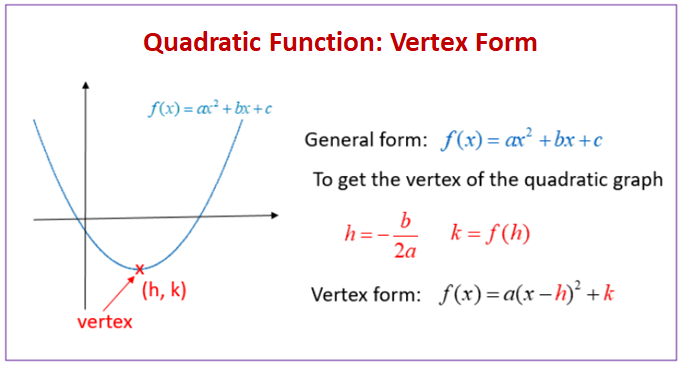Conversion Between Forms
Key points
- Convert between the three forms of quadratic equations:
- Standard Form
- Vertex Form
- Intercept Form
- Convert to standard form by algebraically simplifying.
- Convert to the other forms by finding the vertex/intercepts.
Quadratic functions are modeled in three forms. Each of these forms express a main feature of a parabola.
- Standard form, which is the most common.
- Vertex form, which is used to find the vertex.
- Intercept for, which is used to find the x-intercepts/solutions/zeros.
- Also known as factored form.
Converting to standard form from the other forms is done by algebraically simplifying.
- When converting from vertex form, use the FOIL method to expand the binomial.
- Then, distribute the coefficient.
- Combine like terms.
- When converting from intercept/factored form, use the FOIL method to multiply the two binomials.
- Then, distribute the coefficient and combine like terms.
Since vertex and intercept forms are used to express certain features of the parabola, find those features to convert from standard form. This means that you could convert by graphing. Algebraically:
- For vertex form, find the vertex of the parabola.
- Divide the negative of the second coefficient by double of the first coefficient to find the x value of the vertex.
- -b/2a.
- Plug this value back into the original formula to find the y value of the vertex.
- Divide the negative of the second coefficient by double of the first coefficient to find the x value of the vertex.
- Take the vertex (h,k), and put it into vertex form.
- Convert from standard to intercept form by finding the intercepts.
- Factor the equation or use the quadratic equation.
- These concepts are explained in later notes pages.
When converting from vertex to intercept form (or vice versa), use standard form as an intermediate.
- Convert to standard form before going to the other form.
This example shows how to use the FOIL method.
- This is used to multiply two binomials.
- Helpful when converting to standard form when simplifying algebraically.
- Multiply each term by another from the other binomial.
- Multiply both coefficients and their exponents.
- Combine like terms at the end.
Subscribe to the Inertia Newsletter
IB News, Covid-19 Updates, Deadlines, Tips and Tricks, and Hundreds of Free Resources are Awaiting You!
Features
- IB Question Bank
- Thousands of IB Questions
- Practice Exams
- Detailed Answers
- Ask-A-Question System





